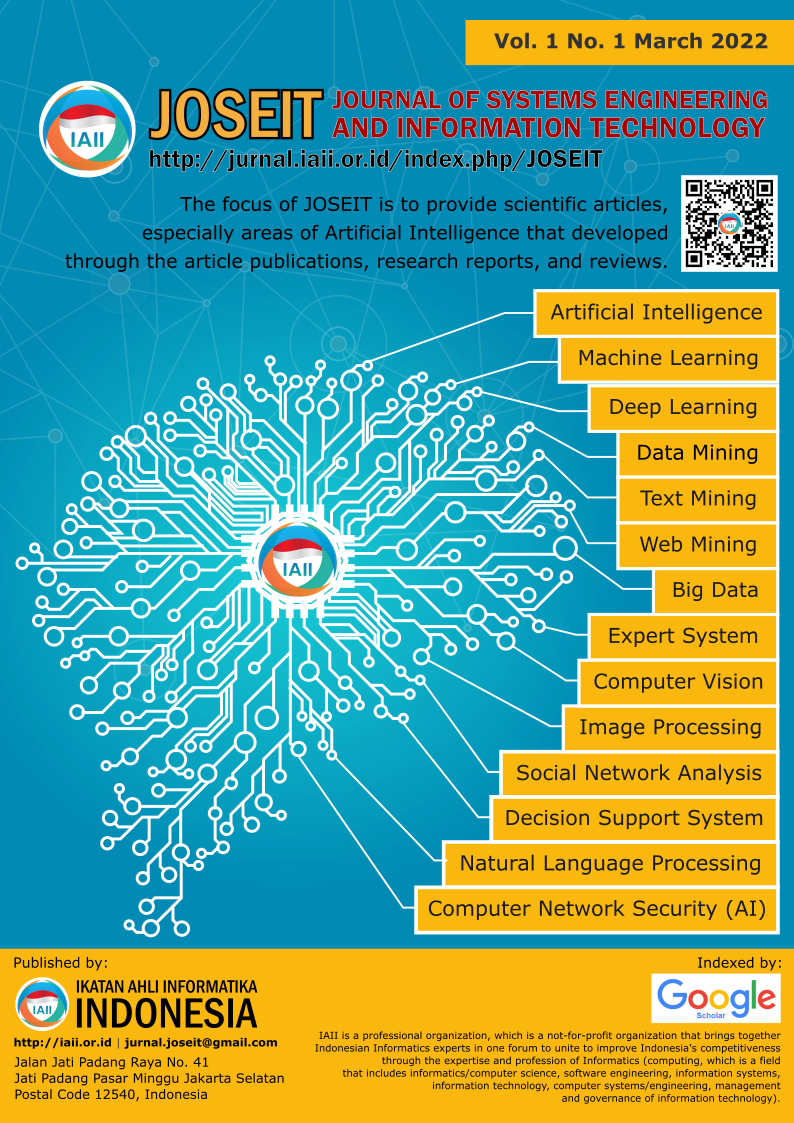Classification of Bullying Comments on YouTube Streamer Comment Sections Using Naïve Bayes Classification
Abstract
One of the social media crimes that is rampant in the current era is cyberbullying. Cyberbullying is a form of intimidation by someone to harass other people using technological devices. this research uses a design for information decision making that aims to get the expected results. the data collection process is carried out manually with a time frame of 1 week by watching the live broadcast of the online game YouTube streamer then sorting out some bullying and non-bullying comments in the comment’s column. Data labeling is done manually. The data obtained amounted to 1000 with 500 negative comments and 500 positive comments. The above test can be concluded that from the distribution of test data there are 90% - 10% have results that are superior to the results of other tests with an increase of 4% in the Naïve Bayes weighting Gain Ratio method. Based on the test data, the results of precision, recall, F1-score and accuracy of the Naïve Bayes classification method are obtained. The test analysis above can be concluded that from the distribution of test data, 90% - 10% have results that are superior to other test results with a 4% increase in the Naïve Bayes weighting Gain Ratio method. The existence of increased accuracy results is due to a randomized data processing process.
Downloads
References
C. Zhu, S. Huang, R. Evans, and W. Zhang, “Cyberbullying Among Adolescents and Children: A Comprehensive Review of the Global Situation, Risk Factors, and Preventive Measures,” Frontiers in Public Health, vol. 9. 2021. doi: 10.3389/fpubh.2021.634909.
M. J. Wang, K. Yogeeswaran, N. P. Andrews, D. R. Hawi, and C. G. Sibley, “How Common Is Cyberbullying among Adults? Exploring Gender, Ethnic, and Age Differences in the Prevalence of Cyberbullying,” Cyberpsychol Behav Soc Netw, vol. 22, no. 11, 2019, doi: 10.1089/cyber.2019.0146.
P. Strickland and J. Dent, “Online harassment and cyber bullying,” House of Commons, no. 07967, 2017.
M. Weinstein, M. R. Jensen, and B. M. Tynes, “Victimized in many ways: Online and offline bullying/harassment and perceived racial discrimination in diverse racial–ethnic minority adolescents.,” Cultur Divers Ethnic Minor Psychol, vol. 27, no. 3, 2021, doi: 10.1037/cdp0000436.
Samsir et al., “Naives Bayes Algorithm for Twitter Sentiment Analysis,” J Phys Conf Ser, vol. 1933, no. 1, p. 012019, Jun. 2021, doi: 10.1088/1742-6596/1933/1/012019.
D. Irmayani, F. Edi, J. M. Harahap, and ..., “Naives Bayes Algorithm for Twitter Sentiment Analysis,” Journal of Physics …, 2021, [Online]. Available: https://iopscience.iop.org/article/10.1088/1742-6596/1933/1/012019/meta
C. A. P. Dita, P. Chairunisyah, and M. Mesran, “Penerapan Naive Bayesian Classifier Dalam Penyeleksian Beasiswa PPA,” Journal of Computer System and Informatics (JoSYC), vol. 2, no. 2, pp. 194–198, 2021.
Y. Findawati, I. R. I. Astutik, A. S. Fitroni, I. Indrawati, and N. Yuniasih, “Comparative analysis of Naïve Bayes, K Nearest Neighbor and C.45 method in weather forecast,” J Phys Conf Ser, vol. 1402, p. 066046, Dec. 2019, doi: 10.1088/1742-6596/1402/6/066046.
K. U. Santoshi, S. S. Bhavya, Y. B. Sri, and B. Venkateswarlu, “Twitter Spam Detection Using Naïve Bayes Classifier,” in 2021 6th International Conference on Inventive Computation Technologies (ICICT), IEEE, Jan. 2021, pp. 773–777. doi: 10.1109/ICICT50816.2021.9358579.
C. Zhang, G.-R. Xue, Y. Yu, and H. Zha, “Web-scale classification with naive bayes,” Proceedings of the 18th international conference on World wide web - WWW ’09, p. 1083, 2009, doi: 10.1145/1526709.1526867.
Copyright (c) 2023 Journal of Systems Engineering and Information Technology (JOSEIT)

This work is licensed under a Creative Commons Attribution 4.0 International License.
Authors who publish with this journal agree to the following terms:
- Authors retain copyright and grant the journal right of first publication with the work simultaneously licensed under Creative Commons Attribution 4.0 International License that allows others to share the work with an acknowledgment of the work's authorship and initial publication in this journal.
- Authors are able to enter into separate, additional contractual arrangements for the non-exclusive distribution of the journal's published version of the work (e.g., post it to an institutional repository or publish it in a book), with an acknowledgment of its initial publication in this journal.
- Authors are permitted and encouraged to post their work online (e.g., in institutional repositories or on their website) prior to and during the submission process, as it can lead to productive exchanges, as well as earlier and greater citation of published work (Refer to The Effect of Open Access).











.png)




